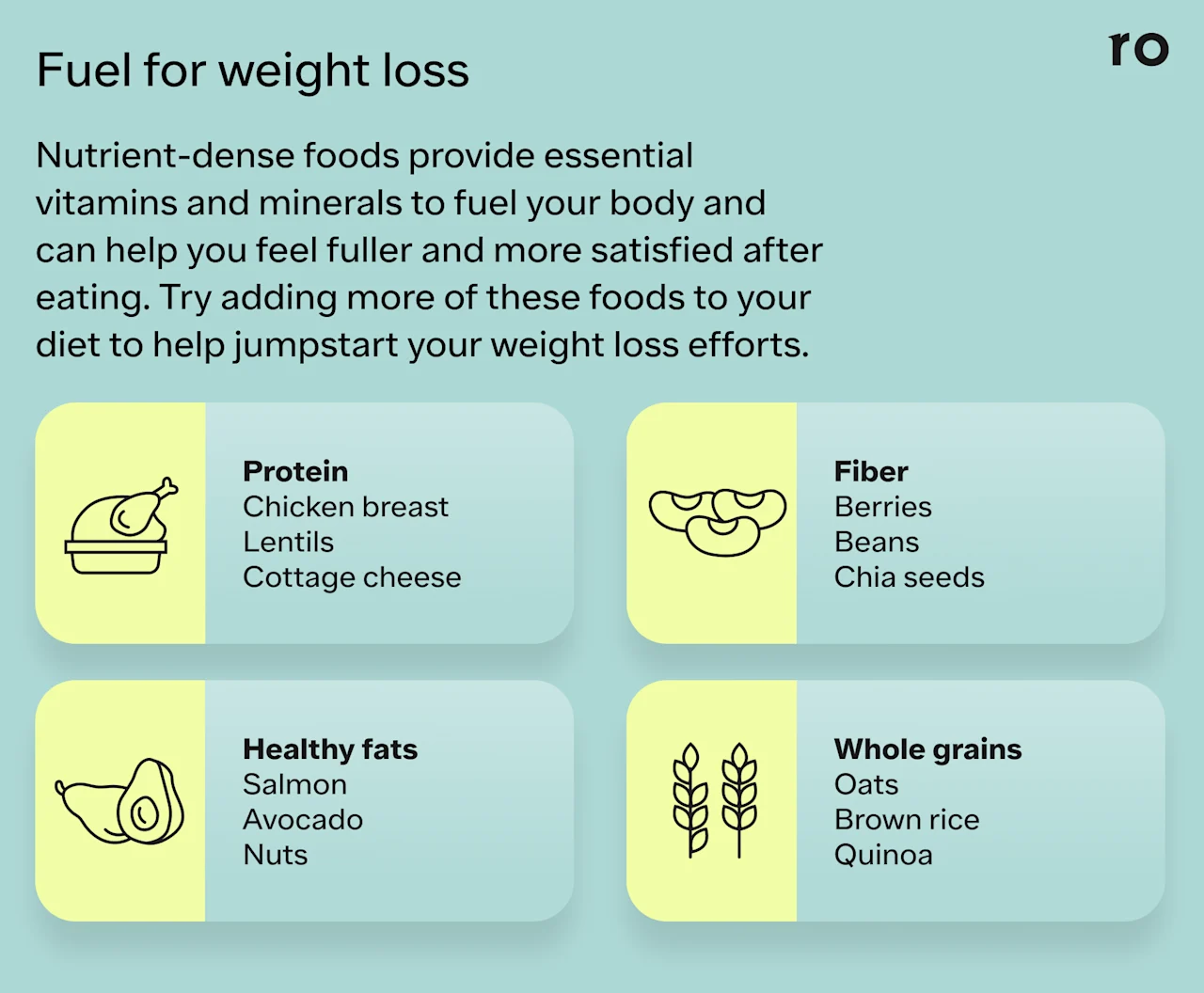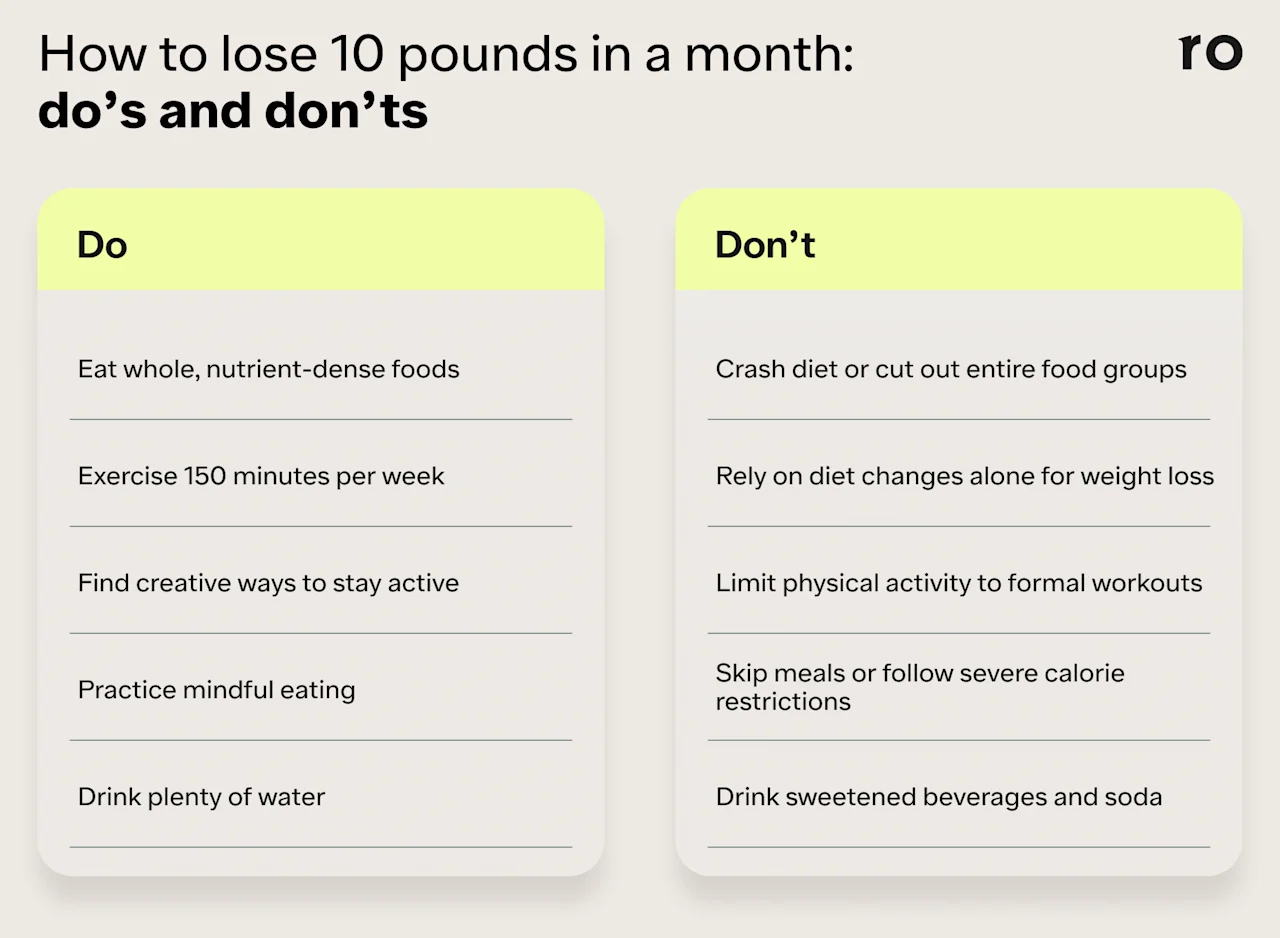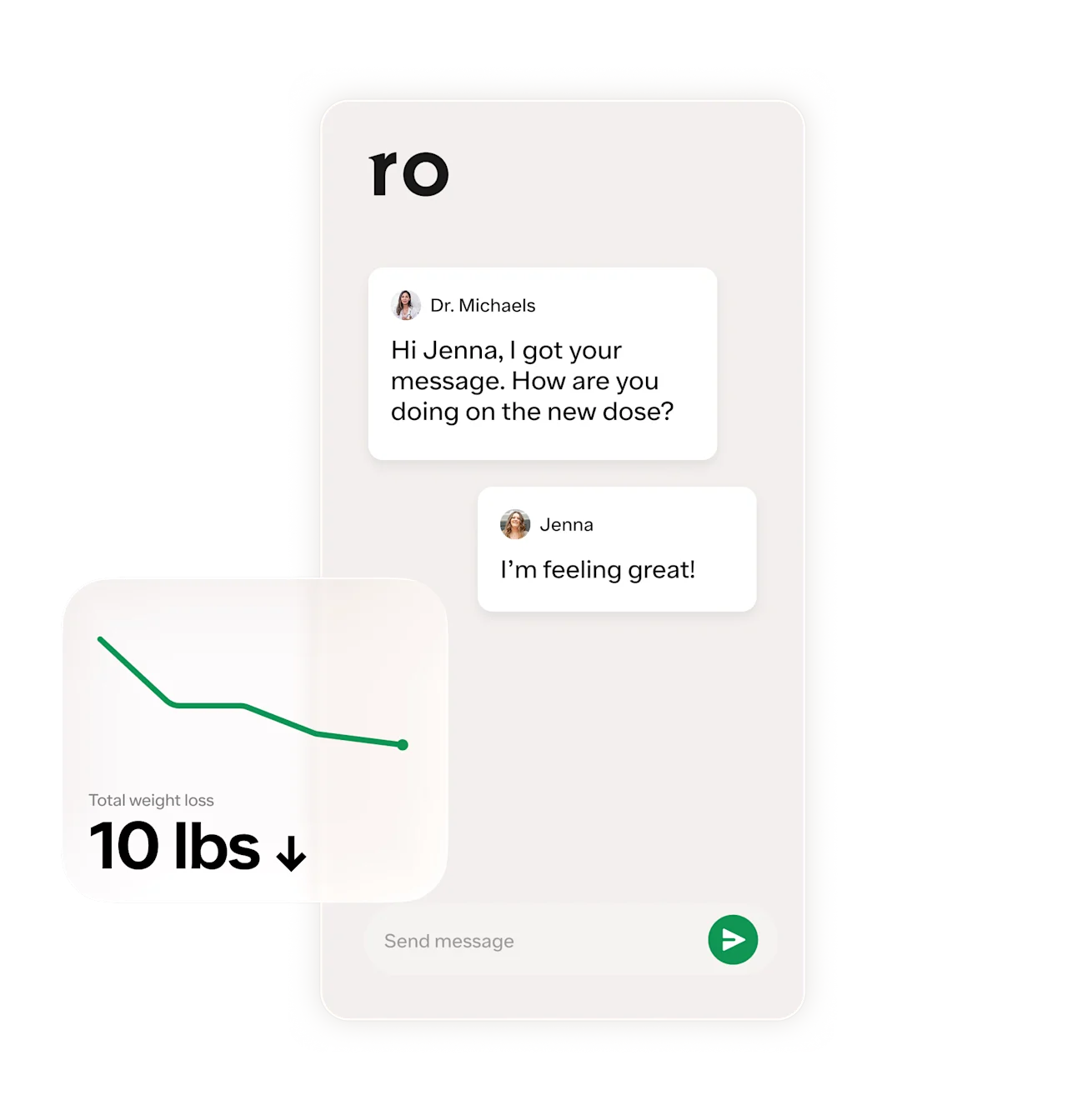Key takeaways
While losing 10 pounds in a month may be possible for some people, it may not be healthy or sustainable for others.
Strategies like combining cardio and strength training, eating in a slight calorie deficit, and reducing stress can help with weight loss.
Experts agree that the best way to lose weight sustainably and safely is to focus on healthy habits that can be maintained long-term.
Avoid extreme weight loss methods or crash diets; while they may promise fast weight loss, they can have negative impacts on your health and may lead to rebound weight gain.
Here's what we'll cover
Here's what we'll cover
Here's what we'll cover
Key takeaways
While losing 10 pounds in a month may be possible for some people, it may not be healthy or sustainable for others.
Strategies like combining cardio and strength training, eating in a slight calorie deficit, and reducing stress can help with weight loss.
Experts agree that the best way to lose weight sustainably and safely is to focus on healthy habits that can be maintained long-term.
Avoid extreme weight loss methods or crash diets; while they may promise fast weight loss, they can have negative impacts on your health and may lead to rebound weight gain.
If you’re on a weight loss journey, you might be curious about strategies to lose weight more quickly.
While it can be tempting to lose weight as fast as possible, most experts agree that focusing on long-term habits instead of quick fixes is generally safer and more sustainable. Extreme diets can be harmful to your health and may even result in rebound weight gain when you stop following them.
Losing 1–2 pounds a week can be a realistic and healthy goal for most people, but weight loss is highly individual and can be influenced by factors like age, health conditions, activity level, and more.
The best way to lose weight in a month is to focus on healthy habits you can consistently follow, such as regular exercise, a balanced diet, good sleep, and stress management.
“Like many worthwhile things in life, there is no silver bullet or one magical way to achieve healthy long-term weight loss,” says Seun Sowemimo, MD, FACS, FASMBS, bariatric surgeon and general surgeon at Endo Surgical Associates of Central Jersey.
“However, one of the keys I have discovered is consistency. Try to find ways to fit your healthy lifestyle into a routine that you follow most of the time.”
No matter where you are on your weight loss journey, it’s important to find the right strategies to support your goals and overall health. This guide will walk you through evidence-based strategies and practical tips for how to lose 10 pounds in a month safely and sustainably.

Step 1 : manage calorie intake
Following a slight calorie deficit can help with weight loss efforts. But before you cut calories, you’ll want to figure out your baseline daily caloric needs.
Your total daily energy expenditure (TDEE) is the number of calories you need to maintain your current weight based on age, gender, weight, height, and activity level.
You can estimate your TDEE using online calculators or apps by inputting information about your height, weight, daily activity, and more.
To maintain weight, eat the same calories as your TDEE.
To lose weight, eat fewer calories than your TDEE.
Cutting 250-500 calories daily can be a safe goal, but the exact amount may vary based on your activity level, dietary needs, and other factors. Calorie-counting tools and apps can help you track your daily intake and make adjustments as needed.
Clinical nutritionist Patricia M. Talerico, DC, MS, advises against drastic calorie cuts, as restrictive “crash” diets can harm your health. “Physically, crash diets can result in extreme fatigue, inability to exercise, and a weakening of immune function,” she says.
Restrictive eating patterns may not be sustainable in the long run, Talerico says, adding that they often lead to regaining weight—and sometimes even more—when you stop following them. “Most people feel very discouraged when this happens and feel as if they have failed,” she says.
A gradual calorie reduction is a healthier approach. It allows your body to adjust and makes long-term progress easier to sustain.
Here are some tips to nurture a healthy relationship with food while reducing calories:
Pay attention to your hunger cues. Eat when you're hungry and stop when you're full.
Focus on moderation, not perfection. Enjoy a variety of foods to avoid feelings of deprivation.
Try meal planning. This can help ensure that you always have healthy, balanced meals and snacks available and can reduce your intake of processed or fast food.
Find out your daily calorie needs
Quickly calculate your total daily energy expenditure to optimize your diet, fitness, and weight goals.
Maintain your current weight
----
CAL DAILY
Lose one pound per week
----
CAL DAILY
This TDEE calculator is for informational purposes only and not a substitute for medical advice. Individual needs vary. Consult a healthcare provider before making changes. Eating fewer than 1,200 (women) or 1,500 (men) calories a day is not recommended.
Step 2 : focus on nutrient-dense foods
When it comes to weight loss, the foods you choose matter.
“Too often we get hung up on what to eat less of and forget about the foods we should be eating more of for overall health,” says Kelli McGrane, MS, RD.
Similarly, Dr. Sowemimo emphasizes the importance of balanced healthy eating that focuses on nutrient-dense, unprocessed foods to help provide the energy your body needs to perform at its best.
Nutrient-dense foods provide essential vitamins and minerals to fuel your body and can help you feel fuller and more satisfied after eating. To jumpstart your weight loss efforts, focus on a four-week diet plan that includes a good balance of macronutrients (fats, carbs, and proteins).

Some tips to help add more nutrients to your diet include:
Prioritize protein. Lean proteins—such as chicken, eggs, Greek yogurt, and lentils—aid muscle repair and promote fullness. Aim to get at least 15% of your daily calories from protein.
Eat more whole grains. Foods like oatmeal, brown rice, and quinoa are fiber-rich, support digestion, and help you feel more satisfied between meals.
Choose healthy fats. Monounsaturated and polyunsaturated fats can help support brain functions and heart health. Foods like salmon, avocados, nuts, and olive oil are all good sources of healthy fats.
Fill up on fiber. High-fiber foods like leafy greens, berries, and beans can also help regulate appetite and support overall digestive health. Studies also show that high fiber content can help stabilize blood sugar levels, further reducing cravings.
Step 3 : cut back on processed foods
Processed foods that are high in sugar and saturated fats. They offer minimal nutritional value and diets high in ultra-processed foods may be associated with a range of health issues that can make weight loss more difficult.
"I personally don't believe that any foods should be avoided completely," McGrane says. "That said, [cutting back on] sweetened beverages, like soda and sweetened fruit juices, are one of the best bangs for your buck if you're looking for an easy way to cut calories and added sugar."
McGrane adds that these drinks don’t satisfy hunger and can also heighten cravings for more sweets. She also advises eating less processed meat, such as bacon and deli meat.
"For overall health, including weight loss, people should focus on incorporating more minimally processed, whole foods into their diets," McGrane says.
Step 4 : combine cardio and strength training
Research shows that combining aerobic exercise and strength training can be an effective way to maximize fat loss. Cardio can boost calorie burn and improve heart health, while strength training can help build muscle and increase your metabolism.
Some examples of cardio workouts include brisk walking, jogging, or high-intensity interval training (HIIT). Strength training exercises include squats, push-ups, bicep curls, and lunges.
“Lifting weights or doing resistance workouts helps maintain or build muscle mass while losing weight,” McGrane says. “This is crucial because muscle is metabolically active, meaning it helps you burn calories even at rest. Plus, lean body mass is vital for bone health and protecting against chronic diseases.”
Mix up your workout routine by alternating between cardio and strength training throughout the week. Aim for 150 minutes of moderate exercise each week, or about 30 minutes a day, five times a week.
Step 5 : stay active (outside of your workouts)
Structured workouts are essential for consistent weight loss, but everyday movement can also help you reach your goals and support your overall health and wellbeing.
“In addition to engaging in purposeful activity, like going for a run or lifting weights at the gym, it’s important to increase your physical activity throughout the day,” McGrane says. “Whether it’s walking to get groceries or taking the stairs instead of the elevator, there are many simple ways to minimize the amount of time you spend sitting down.”
Here's how to make everyday activity count:
Go for a walk. There’s no magic step number, but the benefits of walking are numerous. Taking short walks or parking farther away from your destination can help increase your daily step count.
Take the stairs. Skip the elevator and opt for the stairs to get your heart pumping.
Stretch throughout the day. Take regular breaks to stand, stretch, or walk around, especially if you're working at a desk.
Use active transport. Whenever possible, bike or walk to work or add a walk to your commute to stay active.
Consistency is key! Turning these activities into daily habits can lead to lasting changes, one step at a time.
Step 6 : practice mindful eating
Mindful eating involves fully engaging with what you're eating—eating slowly to savor each bite, recognizing hunger and fullness cues, and paying attention to how food makes you feel.
A 2022 research review suggests that mindful eating can support weight loss and promote a healthier relationship with food.
The goal isn’t to limit what you eat but to better align with your body’s needs. To practice mindful eating, try these tips during your next meal:
Turn off screens and devices.
Take small bites, and chew each bite thoroughly and slowly. Note the flavor, texture, and smell of the food.
Try to spend at least 20 minutes eating.
Check in with your body throughout the meal—assess your hunger and fullness. This can help you tune into your body’s hunger cues.
Step 7 : reduce stress
Stress isn’t just a mental hurdle—it can also impact your weight over time. When you're chronically stressed, your body releases cortisol, a hormone that can increase hunger and promote fat storage, especially around your midsection.
Finding ways to reduce stress can help promote better relaxation and quality of life, and some research shows it may also support your weight loss goals.
Simple, consistent practices can make a difference in how you feel day-to-day. Here are some methods that may be useful for managing stress:
Meditation. Take a few minutes to sit quietly and focus on your breath.
Yoga. Gentle movement combined with deep breathing can help reduce tension and boost your mood.
Deep breathing. Try the 4-7-8 technique—inhale for 4 counts, hold for 7, and exhale for 8—to calm your body.
Mindful walking. Take a short walk and focus on your surroundings to clear your mind.
Make time for what you love. Spending time with friends and family or carving out space for your hobbies can help you feel more connected.
Step 8 : consider meal timing
Studies show that eating at certain times may help boost your metabolism and help keep your energy steady throughout the day.
For example, eating every 3-4 hours can help prevent your blood sugar from dropping too low and better support your metabolism. Eating more frequently instead of having one or two big meals a day may also help you feel more satisfied and energized throughout the day.
Dr. Sowemimo also recommends limiting late-night eating. "Calories consumed at night tend to go into storage as fat since the body is not metabolically active at night due to circadian rhythm," he says.
Step 9 : stay hydrated
Drinking enough water daily is essential for overall health, but it may also benefit weight loss. Research shows staying hydrated supports a healthy metabolism and may help reduce overeating.
Sipping water throughout the day can help regulate hunger, boost your energy, and give your body the support it needs to thrive.
“Staying hydrated is one of the easiest and cheapest ways to support your wellness efforts,” McGrane says. “Not only is water important for nearly every process in your body but drinking water has also been linked with benefits for weight loss."
Step 10 : prioritize good sleep
“Not getting enough, or not getting quality sleep, can also get in your way of losing and maintaining weight,” McGrane says.
Research shows that poor sleep disrupts your hunger hormones, which can increase your intake of high-calorie foods and snacks. On top of that, lack of rest can hinder the body’s ability to burn fat effectively.
Some tips to help improve sleep quality include:
Avoid screens for an hour before bedtime.
Stick to a regular sleep schedule.
Create a relaxing bedtime routine.
Cut back on caffeine and alcohol, especially in the afternoon and evening.
When to seek medical guidance for weight loss
Every weight loss journey is unique. What works for one person may not work for another. While research backs the above weight loss tips, diet and exercise alone may not be enough for everyone.
Certain health conditions—such as hypothyroidism, polycystic ovarian syndrome (PCOS), and type 2 diabetes—can affect metabolism, hormone balance, fat distribution, appetite regulation, or energy levels, making weight loss more challenging.
In some cases, people may need additional support to manage an underlying health condition or aid their weight loss goals.
Talk to your healthcare provider if:
You have trouble sleeping
You're struggling to lose weight despite diet and exercise changes
You notice significant changes in appetite or digestion
You have a history of chronic health conditions
You experience persistent fatigue or low energy levels
You're dealing with mood swings or increased stress
A healthcare provider can evaluate your concerns and overall health history to help tailor treatment to your specific needs. That might include medication to treat an underlying condition, specific diet interventions, or weight loss medication.
Hear from Ro patients
Ro members taking branded GLP-1 medications were paid for their testimonials.
Bottom line
Losing 10 pounds in a month may be a realistic goal for some people, but fast weight loss may not be safe or sustainable. Instead, prioritize healthy weight loss by focusing on consistent, long-term habits like regular exercise, a balanced diet, good sleep and stress management, and adequate hydration.
Here are some other key points to keep in mind for meeting your weight loss goals, be it losing 10 pounds in a month or something else.
Some ways to maximize weight loss include combining cardio and strength training, eating in a slight calorie deficit, and focusing on macronutrients like lean protein, healthy fats, and complex carbs.
Extreme or restrictive diets may promise rapid weight loss but typically aren’t effective in the long run and can lead to health issues, rebound weight gain, and an unhealthy relationship with food.
Weight loss is an individual journey. Lifestyle interventions may be effective for some people, while others may need additional support.
Talk to your healthcare provider before starting a new weight loss regimen. They may be able to provide more tailored support to help you reach your health goals.
Frequently asked questions (FAQs)
Is it possible to lose 10 pounds in a month?
It’s possible to lose 10 pounds in a month, but it may not be the safest or most sustainable way to lose weight for everyone. How quickly a person loses weight can also depend on various factors, including starting weight, activity level, genetics, and more.
“Someone who weighs 400 pounds may be able to lose 10 pounds in a week easily,” Dr. Sowemimo says. “When he gets down close to his optimal weight, that last 10 pounds may take much longer.”
How quickly can you lose 10 pounds?
Most experts agree that a safe weight loss goal is 1-2 pounds per week. At that rate, a person may be able to lose 10 pounds in 5-10 weeks. Weight loss results depend on factors such as your starting weight, metabolism, overall health, lifestyle, and more.
Is losing 10 pounds a month a realistic goal?
Losing 10 pounds a month may be a realistic goal for some, but this depends on various factors, including overall health status, starting weight, activity level, and more. Talk to a healthcare provider before making any major changes to your diet or lifestyle.
The experts interviewed emphasize the importance of consistent, healthy habits—such as regular exercise and eating a nutritious diet—over crash diets and weight loss fads for sustainable and long-term weight loss.
What is the fastest way to lose 10 pounds?
The fastest way to lose 10 pounds may not be the healthiest. Crash diets and other methods that promise rapid weight loss could be harmful to your health and may lead to rebound weight gain once you stop following them.
The best way to lose weight is to find strategies that work for your lifestyle and that you can stick to. This typically includes prioritizing whole, nutrient-dense foods, combining cardio and strength training, managing stress, staying hydrated, and getting quality sleep regularly.
What foods should you eat to lose 10 pounds in a month?
Whole foods such as vegetables, fruits, lean proteins, whole grains, and healthy fats can help support weight loss. This includes foods like:
Lean proteins like chicken breast, eggs, beans, and lentils
Healthy fats like salmon, avocadoes, nuts, and seeds
High-fiber carbs like broccoli, sweet potatoes, and apples
Whole grains like oats, brown rice, and quinoa
You may also want to cut back on processed foods and sugary drinks, such as chips, fast food, soda, and juice. These foods tend to be high in calories, sugar, and unhealthy fats that can promote weight gain and fat storage.
DISCLAIMER
If you have any medical questions or concerns, please talk to your healthcare provider. The articles on Health Guide are underpinned by peer-reviewed research and information drawn from medical societies and governmental agencies. However, they are not a substitute for professional medical advice, diagnosis, or treatment.
References
Armstrong, L. E. & Johnson, E. C. (2018). Water intake, water balance, and the elusive daily water requirement. American Journal of Lifestyle Medicine, 12(6), 463–475. doi: 10.1177/1559827618763497. Retrieved from https://pmc.ncbi.nlm.nih.gov/articles/PMC6315424/
Chianese, R., Coccurello, R., Viggiano, A., et al. (2018). Impact of dietary fats on brain functions. Current Neuropharmacology, 16(7), 1059-1085. doi: 10.2174/1570159X15666171017102547. Retrieved from https://pmc.ncbi.nlm.nih.gov/articles/PMC6120115/
Dabas, J., Shunmukha Priya, S., Alawani, A., et al. (2024). What could be the reasons for not losing weight even after following a weight loss program? Journal of Health, Population, and Nutrients, 43(1), 37. doi: 10.1186/s41043-024-00516-4. Retrieved from https://pmc.ncbi.nlm.nih.gov/articles/PMC10908186/
Elizabeth, L., Machado, P., Zinöcker, M., et al. (2020). Ultra-Processed Foods and Health Outcomes: A Narrative Review. Nutrients, 12(7), 1955. doi: 10.3390/nu12071955. Retrieved from https://pmc.ncbi.nlm.nih.gov/articles/PMC7399967/
Farhana, A. & Rehman, A. (2023). Metabolic consequences of weight reduction. StatPearls. Retrieved from https://www.ncbi.nlm.nih.gov/books/NBK572145/
Hofmeister, M. (2022). Water for weight loss. Canadian Family Physician, 68(11), 796. doi: 10.46747/cfp.6811796. Retrieved from https://pmc.ncbi.nlm.nih.gov/articles/PMC9833168/
Institute of Medicine (US) Subcommittee on Military Weight Management. (2004). Factors that influence body weight. In Weight management: State of the science and opportunities for military programs. National Academies Press (US). Retrieved from https://www.ncbi.nlm.nih.gov/books/NBK221834/
Khana, S. U., Lone, A. N., Khan, M. S., et al. (2021). Effect of omega-3 fatty acids on cardiovascular outcomes: A systematic review and meta-analysis. The Lancet eClinicalMedicine, 38, 100997. doi: 10.1016/j.eclinm.2021.100997. Retrieved from https://www.thelancet.com/journals/eclinm/article/PIIS2589-5370(21)00277-7/fulltext
Liu, S., Wang, X., Zheng, Q., et al. (2022). Sleep deprivation and central appetite regulation. Nutrients, 14(24), 5196. doi: 10.3390/nu14245196. Retrieved from https://pmc.ncbi.nlm.nih.gov/articles/PMC9783730/
National Heart, Lung, and Blood Institute. (n.d.). Causes and risk factors of overweight and obesity. National Institutes of Health. Retrieved from https://www.nhlbi.nih.gov/health/overweight-and-obesity/causes
Nitzke, D., Czermainski, J., Rosa, C., et al. (2024). Increasing dietary fiber intake for type 2 diabetes mellitus management: A systematic review. World Journal of Diabetes, 15(5), 1001–1010. doi: 10.4239/wjd.v15.i5.1001. Retrieved from https://pmc.ncbi.nlm.nih.gov/articles/PMC11099360/
Paoli, A., Tinsley, G., Bianco, A., et al. (2019). The influence of meal frequency and timing on health in humans: The role of fasting. Nutrients, 11(4), 719. doi: 10.3390/nu11040719. Retrieved from https://pmc.ncbi.nlm.nih.gov/articles/PMC6520689/
Pellegrini, C. A., Webster, J., Hahn, K. R.,et al. (2020). Relationship between stress and weight management behaviors during the COVID-19 pandemic among those enrolled in an internet program. Obesity Science & Practice, 7(1), 129–134. doi: 10.1002/osp4.465. Retrieved from https://pmc.ncbi.nlm.nih.gov/articles/PMC7909591/
Tan, J., Krasilshchikov, O., Kuan, G., et al. (2023). The effects of combining aerobic and heavy resistance training on body composition, muscle hypertrophy, and exercise satisfaction in physically active adults. Healthcare (Basel), 11(17), 2443. doi: 10.3390/healthcare11172443. Retrieved from https://pmc.ncbi.nlm.nih.gov/articles/PMC10487730/
Tapper, K. (2022). Mindful eating: What we know so far. Nursing in Breastfeeding. doi: 10.1111/nbu.12559. Retrieved from https://onlinelibrary.wiley.com/doi/10.1111/nbu.12559
van der Valk, E. S., Savas, M., & van Rossum, E. F. C. (2018). Stress and obesity: Are there more susceptible individuals? Current Obesity Reports, 7(2), 193-203. doi: 10.1007/s13679-018-0306-y. Retrieved from https://pmc.ncbi.nlm.nih.gov/articles/PMC5958156/












